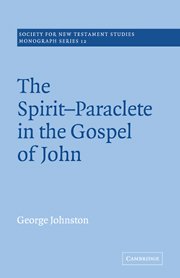Book contents
- Frontmatter
- Contents
- Preface
- Abbreviations
- PART I ‘SPIRIT’ IN THE FOURTH GOSPEL: A GENERAL SURVEY
- PART II THE SPIRIT–PARACLETE, THE SPIRIT OF TRUTH
- Appendix 1 The Literary Structure of John
- Appendix 2 Literary Analysis of John 13–17
- Select Bibliography
- Index of Passages cited
- Index of Authors
- Index of Subjects
Appendix 1 - The Literary Structure of John
Published online by Cambridge University Press: 26 February 2010
- Frontmatter
- Contents
- Preface
- Abbreviations
- PART I ‘SPIRIT’ IN THE FOURTH GOSPEL: A GENERAL SURVEY
- PART II THE SPIRIT–PARACLETE, THE SPIRIT OF TRUTH
- Appendix 1 The Literary Structure of John
- Appendix 2 Literary Analysis of John 13–17
- Select Bibliography
- Index of Passages cited
- Index of Authors
- Index of Subjects
Summary
The Gospel of John is a highly integrated document, one that needs to be read backward (so to speak) as well as forward. Hence it should not be surprising that his attempt to discover the contextual range of the spirit–paraclete sayings compels the investigator to press behind 13: 1 which marks the opening scene of acts and words in the Supper Room in Jerusalem on the betrayal night. It soon becomes clear that one must have a very clear grasp of the book's structure from first to last. Certain divisions suggest themselves quite naturally at first sight:
(a) 1: 1–18, the poetic introduction announcing the incarnation of the Logos in Jesus.
(b) 1: 19–12: 50, the public ministry in Judaea, Galilee and Samaria. Dodd has called this ‘The Book of Signs’.
(c) 13: 1‘17: 26, the Farewell Discourses and the prayer of intercession.
(d) 18: 1‘20: 31, the last days of Jesus and the story of his Resurrection.
(e) 21: 1‘25, apparently an appendix, describing a Galilean Resurrection appearance and the story of Jesus' commission to Peter and his statement about the Beloved Disciple.
Throughout the first twelve chapters, in the narrative of signs, debates and monologues, two controversial matters keep recurring: By what authority does Jesus act and teach? and, Can a satisfactory witness be produced in favour of Jesus' claims? (cf. Mark 11: 27‘33). This whole section has the form of a great contest or assize. From one point of view, God's Word has come in judgment to the world; from another, the Jews have put Jesus on trial for his life and it is foredoomed that he will die.
- Type
- Chapter
- Information
- The Spirit-Paraclete in the Gospel of John , pp. 155 - 161Publisher: Cambridge University PressPrint publication year: 1970



